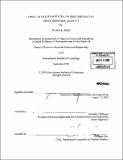| dc.contributor.advisor | Ronald G. Ballinger. | en_US |
| dc.contributor.author | Benz, Julian K | en_US |
| dc.contributor.other | Massachusetts Institute of Technology. Dept. of Materials Science and Engineering. | en_US |
| dc.date.accessioned | 2010-04-28T17:04:34Z | |
| dc.date.available | 2010-04-28T17:04:34Z | |
| dc.date.copyright | 2009 | en_US |
| dc.date.issued | 2009 | en_US |
| dc.identifier.uri | http://hdl.handle.net/1721.1/54580 | |
| dc.description | Thesis (S. M.)--Massachusetts Institute of Technology, Dept. of Materials Science and Engineering, 2009. | en_US |
| dc.description | Cataloged from PDF version of thesis. | en_US |
| dc.description | Includes bibliographical references (p. 106-111). | en_US |
| dc.description.abstract | The effect of oxygen partial pressure on crack growth rates in Alloy 617 has been studied using both static and fatigue loading at 650°C. Tests were conducted at a constant stress intensity factor, K, for static loading conditions or constant AK for fatigue loading using a direct current potential drop measurement system to measure crack length. The oxygen concentration was measured on both the outlet of the test retort as well as in-situ with a probe located directly at the specimen surface. High purity argon gas was used to establish oxygen partial pressures at low as 10-22 atm while premixed oxygen/argon gases were used to vary the oxygen potential. For fatigue loading, the crack path was observed to be transgranular with increasing growth rates as the oxygen concentration was increased. A transition oxygen partial pressure of approximately 10-5 atm was found to exist, at which the fatigue crack growth rates started to increase with increases in oxygen concentration in the environment. Furthermore, fatigue at R = 0.5 also showed a slight increases in growth rates when the frequency was decreased from 2 Hz to 0.1 Hz. In contrast, the fracture surfaces resulting from static loading were found to be intergranular and exhibited two different environmental behaviors. At a stress intensity factor of 49.5 MPa'Im, decreasing the oxygen potential lead to an increase in crack growth rates. However, the static loading crack growth rates 33.0 MPadm exhibited negligible variation with oxygen potential. Detailed microstructural analysis of fracture surfaces and grain boundaries ahead of crack tips was performed using Auger spectroscopy. | en_US |
| dc.description.abstract | (cont.) The results confirm the formation of chromium oxide in the wake of cracking and provide little or no indication of intergranular oxygen diffusion ahead of the crack. However, the resolution of the Auger spectroscopy results was insufficient for a definitive statement in this regard. The observations in this study most closely relate to dynamic embrittlement process involving short range intergranular oxygen absorption under the presence of stress. | en_US |
| dc.description.statementofresponsibility | by Julian K. Benz. | en_US |
| dc.format.extent | 111 p. | en_US |
| dc.language.iso | eng | en_US |
| dc.publisher | Massachusetts Institute of Technology | en_US |
| dc.rights | M.I.T. theses are protected by
copyright. They may be viewed from this source for any purpose, but
reproduction or distribution in any format is prohibited without written
permission. See provided URL for inquiries about permission. | en_US |
| dc.rights.uri | http://dspace.mit.edu/handle/1721.1/7582 | en_US |
| dc.subject | Materials Science and Engineering. | en_US |
| dc.title | Effect of oxygen potential on high temperature crack growth in alloy 617 | en_US |
| dc.type | Thesis | en_US |
| dc.description.degree | S.M. | en_US |
| dc.contributor.department | Massachusetts Institute of Technology. Department of Materials Science and Engineering | |
| dc.identifier.oclc | 568225432 | en_US |
